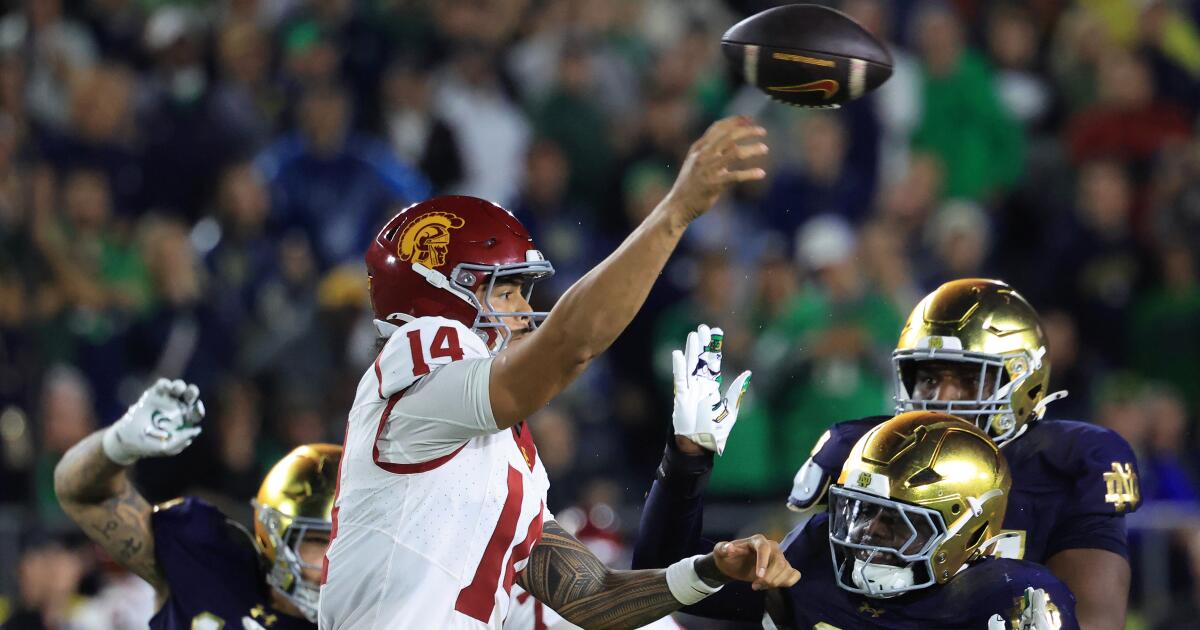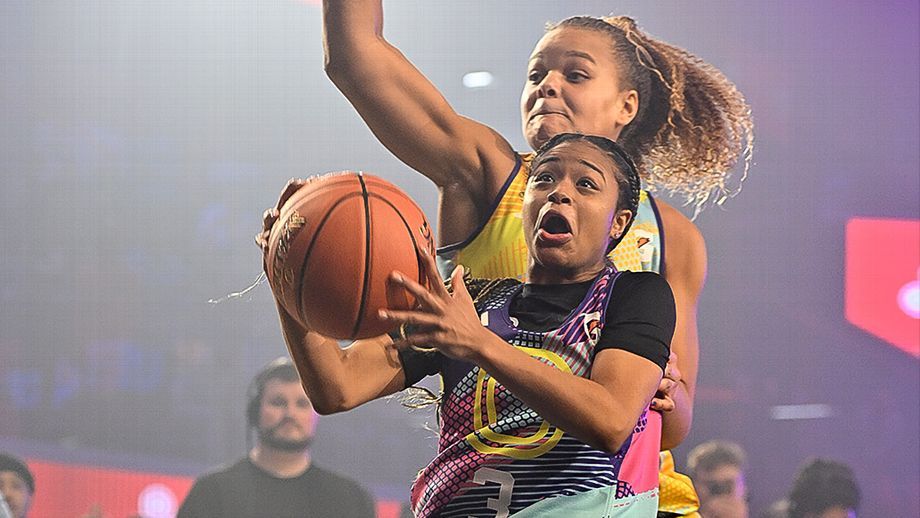
This is read by an automated voice. Please report any issues or inconsistencies here.
SOUTH BEND, Ind. — It was an ominous bit of imagery, at the bitter end of a century-long series. Dark clouds descending over Touchdown Jesus, and a heavy downpour soaking every soul in Notre Dame Stadium, as if Mother Nature was lashing out at the prospect of one of college football’s defining rivalries dying in vain.
Both USC and Notre Dame have suggested they hope the rivalry can continue beyond this season, if they can come to an agreement in the coming months. But if this was indeed the end, 99 years since USC and Notre Dame first met on a football field, it would be a particularly crushing final scene for the 20th-ranked Trojans, who now find their hopes of a College Football Playoff bid hanging by a thread after a 34-24 loss.
“We just flat-out did not play good enough tonight against a good team on the road,” USC coach Lincoln Riley said. “[We] had some missed opportunities that make you sick right now.”
The game seemed well on its way to a different sort of conclusion, when the 13th-ranked Irish shanked a 31-yard field goal in the fourth quarter. Three plays later, USC quarterback Jayden Maiava found wideout Makai Lemon for a 42-yard gain.
The game’s momentum was suddenly back in the hands of Riley and his dynamic offense. That’s when the Trojans coach dialed up a harebrained trick play that even he couldn’t defend when asked about it later.
Sprinting right on an end-around, Lemon took the handoff from Maiava and immediately found himself trapped by the descending Notre Dame defense. So Lemon cocked the ball as if he were going to throw, only to have the ball stripped away.
Asked what led him to choose that particular play, in that particular moment, Riley was curt.
“Stupid call,” he said. “Stupid call.”
It was hardly the first time that Riley’s playcalling has been called into question after a loss. But even he questioned his own decision making Saturday — notably when the Trojans twice came up empty on fourth and short.
“I had the reverse pass and two fourth-down calls that weren’t very good calls and didn’t put our guys in very good positions,” Riley said. “I’ve gotta be way better for our guys.”
The fumble, for Lemon, was a rare misstep from the Trojans’ star wideout, but an especially costly one. It took seven plays for Notre Dame to find the end zone after that, as quarterback C.J. Carr punched it in from one yard out to put the game away.
There were other mistakes made and opportunities squandered Saturday long before the Irish would deal that finishing blow. On the drive before Lemon’s fumble, Maiava threw an interception, his first of two in the final 20 minutes. The drive after, USC failed on a critical fourth and one at midfield, as the Irish blanketed tight end Lake McRee in the flat on a play-action pass.
Of course, the loss couldn’t be distilled down to just a few spare plays, either. USC was steamrolled on the ground by Notre Dame’s rushing attack, which piled up 306 yards, the second-most by any team during Riley’s tenure with the Trojans.
Most of that production came, as expected, from Jeremiyah Love, who burst out of the gate Saturday with a 63-yard scamper. He racked up a career-high 228 rushing yards to go with two touchdowns, as USC’s run defense made simple errors that the Irish exploited with ease.
“I just thought we overcompensated and, at times, panicked a little bit,” Riley said of the run defense.
Their lack of a rushing attack was also a cause for panic. A week after he rushed for 158 yards, King Miller came back to Earth against the Irish, as the walk-on finished with 70 yards in 18 carries. The rest of USC’s run game was a literal net negative, accounting for minus-24 yards.
The disparity between the two rushing attacks was especially stark considering the conditions, as rain poured down, harder and harder with every passing possession in the second half. Instead of counting on the run, which powered its offense in recent weeks, the Trojans were forced to rely on Maiava throwing into a driving rain.
Maiava, who completed a season-low 52% of his passes, said the rain didn’t affect him. But he wasn’t at all happy with how he performed.
“Honestly, just played s—,” Maiava said. “Gotta be better for my teammates.”
USC still managed to create explosive plays from the passing game. Maiava had nine passes of 15 yards or more, the most consequential of which came midway through the third quarter, with USC trailing by five points. He spotted Ja’Kobi Lane charging past the Notre Dame secondary and threw up a prayer into the driving rain. The pass found Lane in perfect stride as he sprinted into the end zone for a 59-yard score.
USC Sports
After public uproar over the potential end of their 100-year old football rivalry, USC has made an amended offer to Notre Dame.
The score handed the Trojans the lead and the game’s momentum … for all of 15 seconds.
On the ensuing kickoff, Jadarian Price weaved through one Trojan, then another before the field opened up in front of him. He didn’t stop until he reached the end zone, 100 yards later, with the Irish in the lead.
It was a wonder the game even reached that point, after heavy thunderstorms soaked the stadium for hours before kickoff, bringing with it lightning that left the game in doubt.
The rain cleared just in time for the rivalry game to kick off on time. But the dark clouds, for USC at least, could loom long past Saturday night. Not only is there a real possibility of no game next year to avenge this defeat, but with two losses on their resume, the Trojans have no remaining margin for error if they still hope to push for a Playoff spot.
USC Sports
This weekend could be the final game in the storied USC versus Notre Dame rivalry after an idea by Netflix was shot down.
That notion felt far-fetched as of Saturday night. But as he spoke to his disappointed team on Saturday night, Riley told them to remember what happened to Ohio State, last season’s national champion, after it lost a crushing rivalry game.
It didn’t lose again.
“In this new age of college football, with all the parity right now, anything is possible,” Riley said.
As for whether the same rationale might apply to the rivalry …
“I don’t worry too much about the future,” Riley said. “Just in the moment right now. And every game means a whole hell of a lot to us right now.”
Get our Times of Troy newsletter for USC insights, news and much more.
By continuing, you agree to our Terms of Service and our Privacy Policy.
Follow Us
Ryan Kartje is the USC beat writer at the Los Angeles Times. He joined The Times after six years with the Southern California News Group. A Michigan native and University of Michigan graduate, Kartje previously wrote for Fox Sports Wisconsin and the Bloomington (Ind.) Herald-Times.
USC Sports
USC Sports
USC Sports
Subscribe for unlimited access
Site Map
Follow Us
MORE FROM THE L.A. TIMES









